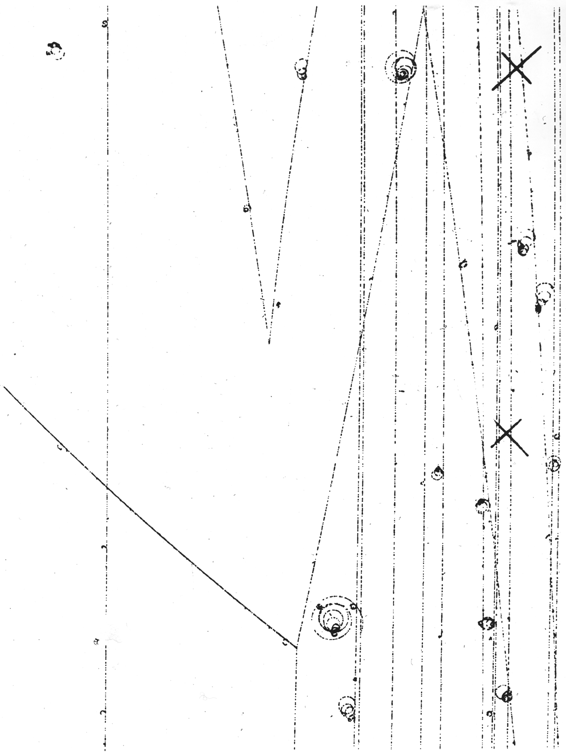![]()
![]() Decay Process
Decay Process
Aim:
To identify the parent particle, which decays into the positive and negative
tracks that have been measured. One can use a trail and error method based on
assigning
![]() and proton p masses to
both of the two particles and comparing with the
and proton p masses to
both of the two particles and comparing with the
![]() and
and
![]() masses.
masses.
 |
|
Fig.1 Bubble chamber picture. The dark lines are trails of tiny bubbles created as charged particles force their way through a tank of transparent liquid enclosed in a powerful magnet. The tracks which curl to the left are electrons-The magnetic field direction is out of the screen. By measuring the curvature of the tracks in the event, one can determine their momenta. Here they are highly relativistic.
Step 1:
Looking at the bubble chamber picture, one can see that the positive and
negative tracks correspond to highly relativistic particles, for which
![]() , or
, or
![]() . The bubble chamber therefore cannot distinguish between
particles of different masses!
. The bubble chamber therefore cannot distinguish between
particles of different masses!
Step 2:
Each final particle momentum was measured in terms of three variables (
![]() ) , from the track curvature.
) , from the track curvature.
Step3: A computer program calculate from them, the momentum components:

Step4:
Table 1 contains the momentum components for each positive and negative
particle. Assuming that they are
![]() and
and
![]() with known masses
with known masses
(
![]() ), one can calculate their final energy, by using the relativistic formula
), one can calculate their final energy, by using the relativistic formula
![]()
|
|
|
|
|
Possible
masses (GeV) |
E (GeV) |
|
Negative particle |
2.80879 |
-0.51130 |
0.45066 |
|
2.8936 |
|
Positive particle |
0.76380 |
0.04410 |
0.04419 |
|
0.7789 |
|
|
3.57259 |
-0.46720 |
0.49485 |
|
3.6725 |
Step5: There are possible three decay processes:
![]()
or

Energy conservation gives the initial particle energy:
![]()
Momentum conservation gives:
![]()
Its magnitude can be calculated using momentum components of each particle:
![]()
Knowing the energy and momentum of the initial particle, one can get its rest mass:
 or
or
![]() in GeV units
in GeV units
The experimental data gives:
![]() very close to the
very close to the
![]() mass (
mass (
![]() )
)
If one replace
![]() by a proton p
, the initial particle mass will be
by a proton p
, the initial particle mass will be
![]() which is very much larger than the
which is very much larger than the
![]() , (
, (
![]() ), which is not consistent with these processes.
), which is not consistent with these processes.